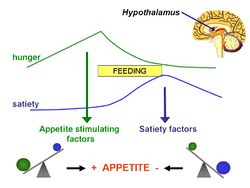Poverty and obesity: Difference between revisions
imported>Hannah Harman No edit summary |
imported>Hannah Harman |
||
| Line 14: | Line 14: | ||
==Dietary Energy Density== | ==Dietary Energy Density== | ||
===Influence on energy intakes=== | |||
Energy dense foods result in higher energy intakes overall - list studies on this | |||
===Function of water content=== | |||
The energy density of foods is determined by their water content - energy dilute foods are well hydrated whereas energy dense foods are comparably dry. Affects satiety. | |||
===Palatability of energy dense foods=== | |||
Sugar and fat stimulate reward centers in brain, resulting in human taste preference. | |||
List studies on whether this is innate or acquired. | |||
==Energy Costs== | ==Energy Costs== | ||
Revision as of 09:17, 20 October 2011
For the course duration, the article is closed to outside editing. Of course you can always leave comments on the discussion page. The anticipated date of course completion is 01 April 2012. One month after that date at the latest, this notice shall be removed. Besides, many other Citizendium articles welcome your collaboration! |
Introduction
Poverty and obesity are very closely linked. In the USA, the highest rates of obesity occur in the poorest population groups. Poverty is associated with lower expenditure on food, and low consumption of fruit and vegetables, and energy-dense foods represent the lowest-cost option for consumers. However, the high energy density and palatability of sweets and fats are associated with higher energy intakes. [1]
Diet Quality
Dietary Energy Density
Influence on energy intakes
Energy dense foods result in higher energy intakes overall - list studies on this
Function of water content
The energy density of foods is determined by their water content - energy dilute foods are well hydrated whereas energy dense foods are comparably dry. Affects satiety.
Palatability of energy dense foods
Sugar and fat stimulate reward centers in brain, resulting in human taste preference. List studies on whether this is innate or acquired.
Energy Costs
References
- ↑ Drewnowski A, Specter SE (2004) Poverty and obesity: the role of energy density and energy costs Am J Clin Nutr 79:6-16 PMID 14684391
